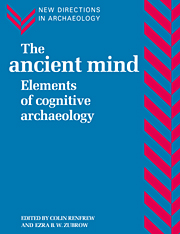Book contents
- Frontmatter
- Contents
- List of figures
- List of tables
- List of contributors
- Preface
- PART I INTRODUCTION
- PART II THE INTERDISCIPLINARY UNDERPINNING
- PART III APPROACHES TO CULT PRACTICE AND TRANSCENDENTAL BELIEF SYSTEMS
- PART IV PREHISTORIC CONCEPTIONS OF SPACE AND TIME
- 10 Symbols and signposts - understanding the prehistoric petroglyphs of the British Isles
- 11 Knowledge representation and archaeology: a cognitive example using GIS
- 12 Dials: a study in the physical representation of cognitive systems
- PART V THE MATERIAL BASIS OF COGNITIVE INFERENCE: TECHNOLOGY
- PART VI THE MATERIAL BASIS OF COGNITIVE INFERENCE: WRITING SYSTEMS
- PART VII CONCLUSION
- Index
11 - Knowledge representation and archaeology: a cognitive example using GIS
Published online by Cambridge University Press: 03 December 2009
- Frontmatter
- Contents
- List of figures
- List of tables
- List of contributors
- Preface
- PART I INTRODUCTION
- PART II THE INTERDISCIPLINARY UNDERPINNING
- PART III APPROACHES TO CULT PRACTICE AND TRANSCENDENTAL BELIEF SYSTEMS
- PART IV PREHISTORIC CONCEPTIONS OF SPACE AND TIME
- 10 Symbols and signposts - understanding the prehistoric petroglyphs of the British Isles
- 11 Knowledge representation and archaeology: a cognitive example using GIS
- 12 Dials: a study in the physical representation of cognitive systems
- PART V THE MATERIAL BASIS OF COGNITIVE INFERENCE: TECHNOLOGY
- PART VI THE MATERIAL BASIS OF COGNITIVE INFERENCE: WRITING SYSTEMS
- PART VII CONCLUSION
- Index
Summary
Introduction
There is an apocryphal story about a famous archaeologist who was excavating an Arikara graveyard. Based on previous work, he believed that the Arikara interred the dead in a systematic manner. He suggested that graves were located in a pattern analogous to a checkerboard. Excavating every third square produced nothing for the entire season. The archaeologist was frustrated. During the last day, a crew member suggested they excavate a unit that was not part of this predetermined pattern. Digging one square to the south of their previous excavations they found a grave with a plethora of funeral offerings. The following season, they excavated the same pattern. By lagging the pattern one square to the south they found a grave in each square.
The story illustrates two important aspects of cognitive archaeology. First, the material culture mediates between the archaeologist's cognition and the cognition of the prehistoric native. Second, the material culture reconciles the past to the present.
Originally, the archaeologist believed he knew the organizing principles that the Arikara were using. As the season progressed, he became convinced that he was mistaken. During the second season, he was reassured that he was correct. The archaeological and the native view of spatial organization appeared to correspond although they were separated by cultural differences and five long centuries. Both parties agreed that the inhabitants of the city of the dead had abodes approximately nine metres apart.
- Type
- Chapter
- Information
- The Ancient MindElements of Cognitive Archaeology, pp. 107 - 118Publisher: Cambridge University PressPrint publication year: 1994
- 23
- Cited by



